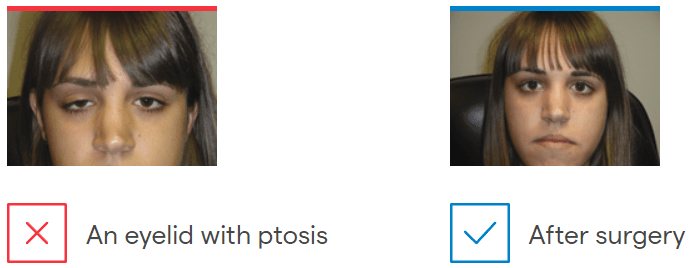
What is childhood eyelid ptosis?
Eyelid ptosis is the drooping of the upper eyelid over the eye to varying degrees of severity. When it occurs before the age of eight, it is known as childhood eyelid ptosis.
As the child is in a period of visual development and growth, one of the specific consequences of not being able to open the eye normally can be the onset of amblyopia, or “lazy eye”.
The affected eye does not receive adequate visual stimuli and does not develop to its full potential.
What causes it?
In adults, ptosis is usually acquired due to advanced age, trauma, muscle diseases or neurological disorders. In children, however, ptosis is usually congenital (present at birth) and related to poor eyelid muscle development.
Childhood ptosis is not usually associated with family history or any other disease. It is usually a consequence of damage during the embryonic development of the eyelid’s levator muscle, which, despite being well connected to the eyelid, lacks the strength to elevate it.
Other less common causes exist, such as allergic reactions, muscle diseases (Steinert), neurological disorders (progressive supranuclear palsy, Horner’s syndrome, myasthenia gravis) and local trauma.
In some exceptional cases, in which onset is rapid, within days or weeks, an eye examination and imaging tests are necessary to detect for serious conditions, such as aneurysms or intracranial tumours.
How can it be prevented?
Ptosis cannot be prevented, but, if detected in time, can be corrected with the appropriate treatment.
If the ptosis is not treated in time, it can:
- Impede the child’s visual development, causing conditions such as amblyopia, or “lazy eye”, strabismus and blurred vision
- Eventually cause the tendon that attaches the levator muscle to the eyelid to weaken and overstretch, resulting in a drooping eyelid and a major obstruction in the pupil
Symptoms

As the drooping of the child’s upper eyelid is clearly visible, ptosis is easily detected. If the condition is congenital, however, with the baby suffering from mild ptosis, it may be difficult to notice any visual impairment for a number of years, by which time the condition may have become more serious. It is important to be attentive during the first years of the baby’s life.
If infants appear to have difficulty keeping their eyes open while they read, write or draw, a specialist should be consulted.
Other symptoms of childhood ptosis include:
- Raising the eyebrows and eyelids
- Tilting the head back to see better
- Lifting the eyelid with a finger
Associated treatments
The treatment for ptosis is surgery. The aim of surgery is to repair the tendon that lifts the eyelid or enable the muscle to recover its usual tone.
IMO currently performs eight different techniques – some of which are ground-breaking in the field –, depending on the characteristics of each case.
Ptosis surgery is not usually performed on patients under the age of five. The reasons for this are that infants usually refuse to cooperate during the pre-operative assessment process, the anatomical structures to be treated are still in the early stages of development and post-operative recovery is too traumatic for small children to endure. The only exception is when there is a risk of amblyopia due to pupillary occlusion or torticollis, in which case the eyelid must be corrected immediately.
In cases of trauma or allergy-related ptosis, patients are advised to wait a few months for the ptosis to subside by itself.
Specialists who treat this pathology
FAQs
The amblyopic eye has not developed vision correctly, but all eye structures are in good condition. Vision develops from birth, and the eye becomes increasingly more capable of perceiving objects, which is called visual acuity. The amblyopic eye does not develop visual acuity for various reasons. The eye is anatomically correct, i.e. its structures are normal, but vision has not developed.
IMO Institute of Ocular Microsurgery
Josep María Lladó, 3
08035 Barcelona
Phone: (+34) 934 000 700
E-mail: international@imo.es
See map on Google Maps
By car
GPS navigator coordinates:
41º 24’ 38” N – 02º 07’ 29” E
Exit 7 of the Ronda de Dalt (mountain side). The clinic has a car park with more than 200 parking spaces.
By bus
Autobus H2: Rotonda de Bellesguard, parada 1540
Autobus 196: Josep Maria Lladó-Bellesguard, parada 3191
Autobuses H2, 123, 196: Ronda de Dalt – Bellesguard, parada 0071
How to arrive at IMO from:
IMO Madrid
C/ Valle de Pinares Llanos, 3
28035 Madrid
Phone: (+34) 910 783 783
See map in Google Maps
Public transport
Metro Lacoma (líne 7)
Autobuses:
- Lines 49 & 64, stop “Senda del Infante”
- Line N21, stop “Metro Lacoma”
Timetables
Patient care:
Monday to Friday, 8 a.m. to 9 p.m.
IMO Andorra
Av. de les Nacions Unides, 17
AD700 Escaldes-Engordany, Andorra
Phone: (+376) 688 55 44
See map in Google Maps
IMO Manresa
C/ Carrasco i Formiguera, 33 (Baixos)
08242 – Manresa
Tel: (+34) 938 749 160
See map in Google Maps
Public transport
FGC. Line R5 & R50 direction Manresa. Station/Stop: Baixador de Manresa
Timetables
Monday to Friday, 09:00 A.M – 07:00 PM









